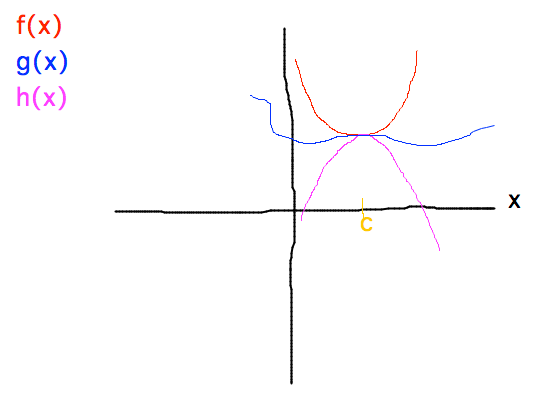- “Limit Laws” part of section 2.2
- Limit laws, for e.g., addition
- Taking a limit distributes over +, -, multiplication, division, powers, roots
- e.g., limx→c( f(x) + g(x) ) = limx→cf(x) + limx→cg(x)
- Theorems, e.g., Sandwich Theorem?
- Limit of polynomial
- Polynomial is f(x) = anxn + an-1xn-1 + ... + a1x + a0
- limx→c(anxn + an-1xn-1 + ... + a1x + a0)
- = ancn + an-1cn-1 + ... + a1c + a0
- Because of
- Addition law
- limx→c(anxn + an-1xn-1 + ... + a1x + a0)
- = limx→canxn + limx→can-1xn-1 + ...
- Constant multiple rule
- limx→canxn + limx→can-1xn-1 + ...
- = an limx→cxn + an-1 limx→cxn-1 + ...
- Power law
- an limx→cxn + an-1 limx→cxn-1 + ...
- = an (limx→cx)n + an-1 (limx→cx)n-1 + ...
- = ancn + an-1cn-1 + ... + a1c + a0
- Addition law
- Limit of rational function (ratio of 2 polynomials, p(x) & q(x))
- limx→c( p(x) / q(x) ), given q(c) ≠ 0
- = p(c) / q(c)
- Because
- Quotient rule
- Limit of polynomial
- limx→c( p(x) / q(x) ), given q(c) ≠ 0
- Sandwich Theorem?

- Limit of polynomial
- Limit laws, for e.g., addition
- Examples
- limx→0( x cosx )
- (at least) 2 ways of figuring this out, the first of which demonstrates
Sandwich Theorem
- -|x| ≤ x cosx ≤ |x| because -1 ≤ cos x ≤ 1
- limx→0-|x| = limx→0|x| = 0
- So Sandwich Theorem says limx→0( x cosx ) = 0
- Or
- limx→0( x cosx )
- = limx→0(x) limx→0(cosx )
- = 0 × 1 = 0
- Or just plug x = 0 into x cosx
- You can do this because x cosx is continuous around x = 0,
i.e., has no breaks in its graph

- If f(x) is continuous around c then limx→cf(x) = f(c)
- But technically using continuity like this to find a limit is circular, because the definition of continuity is that the limit equals the function value—but as long as we’re doing limits intuitively, continuity is an easy property to recognize by intuition.
- You can do this because x cosx is continuous around x = 0,
i.e., has no breaks in its graph
- (at least) 2 ways of figuring this out, the first of which demonstrates
Sandwich Theorem
- If limx→0f(x) = 3 and limx→0g(x) = 16, what is
- limx→0( f(x) + g(x) )?
- Sum rule: 3 + 16 = 19
- limx→0( √g(x) )?
- root rule: √16 = 4
- limx→0( f(x) + g(x) )?
- limx→0( x cosx )
- Think of idea of limit as where function seems to be heading across a small gap in its graph
- If function heads for the same value no matter how small you make the gap, then that value is the limit

- limx→cf(x) = L iff for any ε > 0 you can find a δ such that whenever 0 < | x - c | < δ, then 0 < | f(x)- L | < ε
- More on the formal definition of limit
- Section 2.3 (“The Precise Definition of a Limit”)